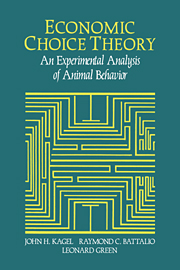Book contents
- Frontmatter
- Contents
- Preface
- Chapter 1 Introduction
- Chapter 2 Commodity-choice behavior I: Some initial tests of the theory
- Chapter 3 Commodity-choice behavior II: Tests of competing motivational processes and the representative consumer hypothesis
- Chapter 4 Labor-supply behavior I: Initial tests of the theory with some public policy implications
- Chapter 5 Labor-supply behavior II: Tests of competing motivational processes and earnings distributions for animal workers
- Chapter 6 Choices over uncertain outcomes
- Chapter 7 Intertemporal choice
- Chapter 8 Summing up
- Bibliography
- Index
Chapter 2 - Commodity-choice behavior I: Some initial tests of the theory
Published online by Cambridge University Press: 22 March 2010
- Frontmatter
- Contents
- Preface
- Chapter 1 Introduction
- Chapter 2 Commodity-choice behavior I: Some initial tests of the theory
- Chapter 3 Commodity-choice behavior II: Tests of competing motivational processes and the representative consumer hypothesis
- Chapter 4 Labor-supply behavior I: Initial tests of the theory with some public policy implications
- Chapter 5 Labor-supply behavior II: Tests of competing motivational processes and earnings distributions for animal workers
- Chapter 6 Choices over uncertain outcomes
- Chapter 7 Intertemporal choice
- Chapter 8 Summing up
- Bibliography
- Index
Summary
In our initial applications of economic theory to animal choice we presented subjects with choices between different edible commodities. This chapter reviews and synthesizes the results from these studies. Sections 2.1 and 2.2 describe the theoretical concepts underlying the experiments and the procedures employed in them. Section 2.3 presents a series of experiments testing for income-compensated (Slutsky) substitution effects, an essential element of consumer-demand theory. Results from both essential and nonessential commodity-choice experiments consistently show reduced consumption in response to income-compensated price increases, as the theory requires.
Section 2.4 reports income-constant demand curves – which represent subjects' responses to changing prices while income is held constant – for both normal and inferior goods. In the case of normal goods, consumption increases when price decreases, as the law of demand requires. For inferior goods, we identify portions of the choice space over which consumption decreases as price decreases, at least for some individuals. That is, we confirm the existence of a Giffen good. This has a number of important theoretical implications, which are discussed in Chapter 3.
In Section 2.5 we extend the analysis of commodity-choice behavior to optimal foraging behavior, a subject of concern to both biologists and psychologists. We show how elements of the marginal value theorem, which was developed by biologists to analyze foraging in patchy environments, follows directly from consumer-demand theory. However, a more formal analysis of the mathematical relationship between demand theory and the marginal value theorem reveals some differences (see the appendix to this chapter).
- Type
- Chapter
- Information
- Economic Choice TheoryAn Experimental Analysis of Animal Behavior, pp. 8 - 46Publisher: Cambridge University PressPrint publication year: 1995

